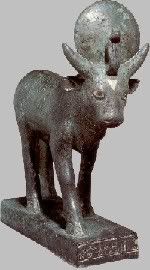

The Sacred Bull, Apis, was said to be Ptah incarnate or sometimes Osiris. It was said Ptah impregnated a virgin cow in the form of a sacred ray of light from the moon to be born as Apis. This cow would have no other offspring. The Greeks called the bull Serapis or Sarapis, and identified him with aspects of Zeus, Helios, Asklepios, and Dionysus. Apis was also known as Asar-Hap, Usar-Hapi, Hapi, Hap, or Hape. This is most likely a derivative of Asari or Usire, originally an agricultural god of Syria later confused with Osiris. Other sacred bulls include Mnevis (or Wer-mer, the incarnation of the sun) and Buchis (the incarnation of the warrior god Menthu).
Apis is depicted as entirely black in color with a small triangle of white on the forehead. The priests in their search for the new Bull used this and other physical signs for identification. A crescent moon marking was found on the right side of its neck and a sign resembling a hawk or vultureís wings appeared on its rump. Under its tongue was a scarab-like lump. Herodotus said the hair of its tail was doubled (though Iím not sure what that means). The owner of the new Bull was compensated with gifts of gold. In art, it is shown with a sun disc, or in later times, the moon and the uraeus between its horns and a silver triangle affixed to its forehead. Above his legs, outstretched wings were outlined, and on his back, a rectangular cloth with an ornamental diamond pattern was represented.
The day of a new Bullís birth was celebrated with an annual festival. Before the new calf was taken to the temple, it was isolated for forty days, attended only by women. Each day of its life, the Sacred Bull was set free in the courtyard attached to the temple, and the priests would use his movements to divine the future. The average life of the Apis bull was fourteen years, at the end of which time, the Bull was mummified in the style of the pharaohs, complete with costly oils, jewels, and grave goods, and interred in a huge sarcophagi. The Bull was usually allowed to die of old age, but if he lived past the age of twenty-eight, he was drowned in a fountain. Its death was followed by seventy days of mourning. The Persians twice assassinated the Bull.
Sixty-four mummified bulls were found at the Serapeum at Sakkarah near Memphis in 1851. Each sarcophagus weighed approximately fifty-eight tons each. When one of the oldest sarcophagus was opened, it was found undisturbed after a period of some 3000 years, and the footprints of the mourners were still visible. Rufinus described the temple of Serapis at Alexandria as being one of the greatest wonders of antiquity. It towered above the city on a foundation one hundred steps high.